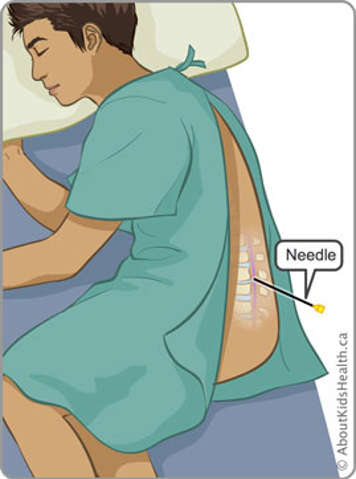
Why do I need a lumbar puncture?
Your brain and your spinal cord (and the CSF that surrounds them) are called your central nervous system (CNS). They are separated from the rest of your body by a thin sheet called a membrane. The membrane protects your central nervous system and keeps it safe from any infections in your body.
Cancer cells can sometimes cross this membrane and spread into your central nervous system. Your doctors can check your CSF for cancer cells to see if this has happened. They may also look in the CSF for the different chemicals that tumours make to help diagnose your cancer.
Sometimes doctors also give chemotherapy (drugs to treat cancer) through the needle when they do your lumbar puncture. This will kill any cancer cells in your central nervous system.
How are lumbar punctures done?
Lumbar punctures are usually done in either an operating room or a special treatment room. The doctor or nurse practitioner will do your lumbar puncture. It usually takes about 5 to 15 minutes.
Most teens with cancer will have their lumbar puncture done under sedation. This means you will be given an anaesthetic so that you’ll be asleep and you won’t feel the needle. Or, if you prefer, the procedure can be done with just a local anaesthetic that will only numb part of your lower back but still allow you to stay awake. Once the anaesthetic is working, the test will begin. Talk to your health-care team about the anaesthetic options for this procedure to decide what is best for you.
Your parents will be able to stay with you for encouragement and support either until you fall asleep or sometimes throughout the test if you’re awake.
The doctor or nurse practitioner will ask you to lie on your side with your knees curled up to your chest. You will need to lie very still. Then, the doctor or nurse practitioner will uncover the lower part of your back and clean the skin (which might feel cold) over the area where they will do the test.
During the lumbar puncture, the doctor or nurse practitioner will put a very thin needle between two bones in the lower part of your spine, into the CSF space. A small amount of CSF (about 5 mL) will be collected and then the needle will be removed.
You will feel little or no pain once you have the anaesthetic. If you’re awake, you might feel some pressure as the needle goes in.
The CSF will be sent to the lab to be looked at under a microscope by a specialist doctor called a pathologist (say path-OL-uh-jist).
After a lumbar puncture
You may have a sticky bandage where the needle went in. You will be asked to lay flat for one hour after your lumbar puncture. Most people feel fine after a lumbar puncture, but a few may have a headache. If this happens, you will be asked to lay flat for a few hours longer and a nurse will monitor you. Your doctor or nurse will explain any other side effects to watch for after a lumbar puncture.
You may need to wait a number of days for the results of a lumbar puncture.
Remember, your best source of information about lumbar punctures is your health-care team.
